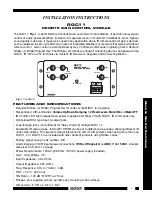
FLIR
LEPTON® Engineering Datasheet
The information contained herein does not contain technology as defined by the EAR, 15 CFR 772, is publicly available,
and therefore, not subject to EAR. NSR (6/14/2018).
Information on this page is subject to change without notice.
Lepton Engineering Datasheet, Document Number: 500-0659-00-09 Rev: 203
34
Table 5 - Typical Radiometric Accuracy after Per Unit Calibration.
T Ambient
0°C
30°C 60°C
T Scene
10°C
±5°C ±5°C ±6°C
50°C
±5°C ±3°C ±3°C
100°C ±5°C ±4°C ±3°C
A protective window will also affect intra-scene temperature range. Any environmental or system factors that
reduce the flux received by the sensor will lower the lower limit, and raise the upper limit, of the range. Such
factors will also decrease sensitivity and possibly even accuracy, so should normally be kept to a minimum.
3.6
AGC Modes
There are two AGC modes:
•
AGC disabled (default)
•
AGC enabled
(see AGC HEQ Output Scale Factor and AGC Calculation Enable State in the Software IDD for
additional, related options)
AGC is a process whereby the large dynamic range of the infrared sensor is collapsed to a range more appropriate
for a display system. For Lepton, this is a 14-bit to 8-bit conversion. In its most simplistic form, AGC can be a linear
mapping from 14-bit to 8-bit; however, a simple linear AGC is generally incapable of providing pleasing imagery in
all imaging conditions. For example, when a scene includes both cold and hot regions (for example, a hot object in
front of a cold background as illustrated in
), linear AGC can produce an output image in which most
pixels are mapped to either full black or full white with very little use of the gray-shades (8-bit values) in between.
Because of this limitation of linear AGC, a more sophisticated algorithm is preferred.
Similar to most AGC algorithms that optimize the use of gray-shades, Lepton's is histogram-based. Essentially a
histogram counts the number of pixels in each frame that have a given 14-bit value.
illustrates the
concept for a 3x3 pixel area.
















































